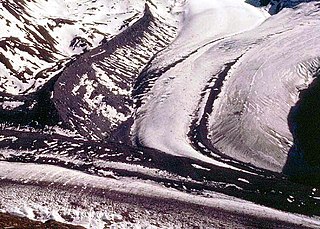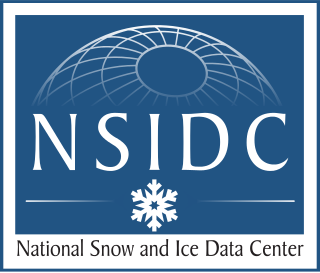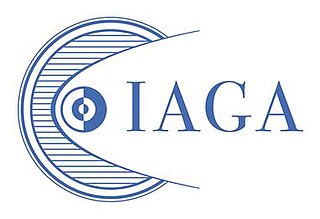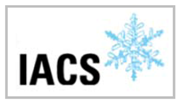
The cryosphere is an all-encompassing term for the portions of Earth's surface where water is in solid form, including sea ice, lake ice, river ice, snow cover, glaciers, ice caps, ice sheets, and frozen ground. Thus, there is a wide overlap with the hydrosphere. The cryosphere is an integral part of the global climate system with important linkages and feedbacks generated through its influence on surface energy and moisture fluxes, clouds, precipitation, hydrology, atmospheric and oceanic circulation. Through these feedback processes, the cryosphere plays a significant role in the global climate and in climate model response to global changes. Approximately 10% of the Earth's surface is covered by ice, but this is rapidly decreasing. The term deglaciation describes the retreat of cryospheric features. Cryology is the study of cryospheres.

Geophysics is a subject of natural science concerned with the physical processes and physical properties of the Earth and its surrounding space environment, and the use of quantitative methods for their analysis. Geophysicists, who usually study geophysics, physics, or one of the earth sciences at the graduate level, complete investigations across a wide range of scientific disciplines. The term geophysics classically refers to solid earth applications: Earth's shape; its gravitational, magnetic fields, and electromagnetic fields ; its internal structure and composition; its dynamics and their surface expression in plate tectonics, the generation of magmas, volcanism and rock formation. However, modern geophysics organizations and pure scientists use a broader definition that includes the water cycle including snow and ice; fluid dynamics of the oceans and the atmosphere; electricity and magnetism in the ionosphere and magnetosphere and solar-terrestrial physics; and analogous problems associated with the Moon and other planets.

Glaciology is the scientific study of glaciers, or more generally ice and natural phenomena that involve ice.

The National Snow and Ice Data Center (NSIDC) is a United States information and referral center in support of polar and cryospheric research. NSIDC archives and distributes digital and analog snow and ice data and also maintains information about snow cover, avalanches, glaciers, ice sheets, freshwater ice, sea ice, ground ice, permafrost, atmospheric ice, paleoglaciology, and ice cores.

The World Glacier Monitoring Service (WGMS) was started in 1986, combining the two former services PSFG and TTS/WGI. It is a service of the International Association of the Cryospheric Sciences of the International Union of Geodesy and Geophysics as well as of the World Data System of the International Council for Science and works under the auspices of the United Nations Environment Programme (UNEP), the United Nations Educational, Scientific and Cultural Organisation (UNESCO), and the World Meteorological Organization (WMO)

The Cooperative Institute for Research in Environmental Sciences (CIRES) is a research institute that is sponsored jointly by the National Oceanic and Atmospheric Administration (NOAA) Office of Oceanic and Atmospheric Research (OAR) and the University of Colorado Boulder (CU). CIRES scientists study the Earth system, including the atmosphere, hydrosphere, cryosphere, biosphere, and geosphere, and communicate these findings to decision makers, the scientific community, and the public.
The Canadian Geophysical Union (CGU) began as a society dedicated to the scientific study of the solid earth and has evolved into one that is concerned with all aspects of the physical study of Earth and its space environment, including the Sun and solar system. To express this broader vision of the geophysical sciences, the Union has adopted a sectional structure that allows individual sections to function as semi-autonomous entities.

Ye Duzheng was a Chinese meteorologist and academician at the Chinese Academy of Sciences.

The International Association of Volcanology and Chemistry of the Earth's Interior (IAVCEI) is a learned society that focuses on research in volcanology, efforts to mitigate volcanic disasters, and research into closely related disciplines, such as igneous geochemistry and petrology, geochronology, volcanogenic mineral deposits, and the physics of the generation and ascent of magmas in the upper mantle and crust. It is one of eight constituent associations of the International Union of Geodesy and Geophysics (IUGG).

The International Union of Geodesy and Geophysics is an international non-governmental organization dedicated to the scientific study of Earth and its space environment using geophysical and geodetic techniques.
The year 2006 was declared the International Year of Deserts and Desertification by the United Nations General Assembly. The Year aims to raise $20 million from industry and governments and will spend half on co-funding research, and half on "outreach" activities. It will be the biggest ever international effort to promote the Earth sciences. Apart from researchers, who are expected to benefit under the Year's Science Programme, the principal target groups for the Year's broader messages are:

The International Permafrost Association (IPA), founded in 1983, is an international professional body formed to foster the dissemination of knowledge concerning permafrost and to promote cooperation among individuals and national or international organisations engaged in scientific investigation and engineering work related to permafrost and seasonally frozen ground. The IPA became an Affiliated Organisation of the International Union of Geological Sciences in July 1989.
Liviu Constantinescu was a Romanian geophysicist, professor of geophysics, member of the Romanian Academy. He was the cofounder, together with Sabba S. Ștefănescu, of the Romanian school of geophysics.

The International Association of Geomagnetism and Aeronomy (IAGA) is an international scientific association that focuses on the study of terrestrial and planetary magnetism and space physics.
The International Association of Hydrological Sciences (IAHS) is a non-profit, non-governmental scientific organization committed to serving the science of hydrology and the worldwide community of hydrologists. The IAHS was established in 1922, and presently claims a membership in excess of 9,000 with members in over 150 countries.

Harsh Kumar Gupta is an Indian earth scientist and seismologist, known for his pioneering work on estimation of reservoir-induced earthquakes. He is a former vice chancellor of the Cochin University of Science and Technology (CUSAT) and a Raja Ramanna Fellow at the National Geophysical Research Institute (NGRI), Hyderabad. A recipient of the 1983 Shanti Swarup Bhatnagar Prize for Science and Technology, the highest Indian award in the science and technology category, and the 2008 Waldo E. Smith Award, Gupta was awarded the fourth highest Indian civilian honour of the Padma Shri in 2006.
Natalya Gomez is a professor, researcher, cryosphere and sea level expert whose research primarily centers around the interactions between ice sheets, sea level, and earth in the past, present and future. Gomez is a professor at McGill University, a Canada Research Chair in Geodynamics of Ice sheet - Sea level interactions, and received the AGU Cryosphere Early Career Award in 2019.

International Association for the Physical Sciences of the Oceans (IAPSO) is one of eight associations of the International Union of Geodesy and Geophysics (IUGG), constituted within the International Science Council (ISC). It was founded in 1919 as an oceanographic section of the IUGG and renamed an association in 1931. IAPSO is the primary body responsible for maintaining and improving oceanographic standards and practices. The President of IAPSO is Dr. Hans van Haren.

International Association of Meteorology and Atmospheric Sciences (IAMAS) is a non-governmental organization aimed to promote and advance a number of atmospheric sciences through conferences, workshops and publications. IAMAS and its commissions bring together experts from around the world to enhance scientific understanding and prediction of the atmosphere’s behavior and its connections to and effects on other components of the Earth’s geophysical system. IAMAS is one of eight associations of the International Union of Geodesy and Geophysics (IUGG). It was created at the First IUGG General Assembly in 1922 as the Meteorology Section and was renamed to International Association and of Meteorology in 1957. Since 1993, it holds its current name – the International Association of Meteorology and Atmospheric Sciences.

International Association of Seismology and Physics of the Earth's Interior (IASPEI) is an international organization promoting the study of earthquakes and other seismic sources, the propagation of seismic waves, and the internal structure, properties and processes of the Earth.















